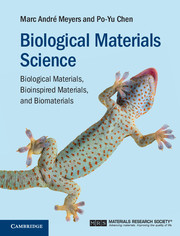1 - Evolution of materials science and engineering: from natural to bioinspired materials
Published online by Cambridge University Press: 05 August 2014
Summary
Early developments
For one brief moment, as one of us (MAM) walked into one of the fabled rooms of the British Museum, he was handed a tool used by early hominids two million years ago. The stone had a barely recognizable sharp edge but possessed a roundish side that fit snugly into the hand. It could have been used to cut through meat, scrape a skin, or crack a skull (Fig. 1.1). It was a brief but emotional event until the zealous anthropologist removed it from the hand that eagerly clasped the artifact and imagined himself deep in the Olduvai Gorge, slicing through the hide of a gazelle that had been hunted down by the group. This connection is at the heart of this book.
The first materials were natural and biological: stone, bones, antler, wood, skins. Figure 1.2(a) shows an Ashby plot of strength vs. density, for early neolithic materials. These natural materials gradually gave way to synthetic ones as humans learned to produce ceramics, then glass and metals. Some of the early ceramics, glasses, and metals are also shown in the plot, and they provide added strength. These synthetic materials expanded the range of choices and significantly improved the performance of tools. The long evolution of materials, from the stone shown in Fig. 1.1 to the cornucopia of materials developed in the past century, is shown in Fig. 1.2(b). Contemporary materials are of great complexity and variety, and they represent the proud accomplishment of ten thousand years of creative effort and technological development.
- Type
- Chapter
- Information
- Biological Materials ScienceBiological Materials, Bioinspired Materials, and Biomaterials, pp. 1 - 16Publisher: Cambridge University PressPrint publication year: 2014



